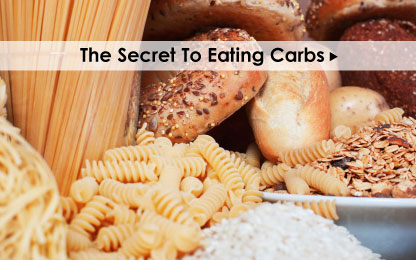The Secret to Eating Carbs
By now we’re all well aware of the low-carb diet craze, and many have tried to skip the bread from time to time, often with mixed results. Most of us are still left asking: What exactly is all the fuss about?
When you munch on a muffin or take a swig of Gatorade, here’s what happens to the carbs that you just put in your mouth; they’re converted into glucose, which is essentially the body’s energy. The problem is that there’s only so much glucose that you actually need. The rest is converted into glycogen and stored in the liver and in your muscles. When glycogen storage reaches full capacity, all the extra carbs are converted into fat.
How Many Carbs Are Too Many?
When it comes to carbs, there’s a range, depending on several factors. First and most important, how much time you’re putting in on a treadmill or at the gym is crucial to managing carbs. An elite athlete needs more carbs to fuel her lifestyle than someone who spends most of her day sitting at a computer.
Here’s a ballpark range of what’s appropriate, safe and effective, depending on your level of activity
0-50g Carbs Per Day:
If you’re trying to lose a lot of water weight in a couple days, cut your carbs below 50/day. This isn’t easy to do, and very restrictive, but any professional model or bodybuilder knows it’s the fastest way to lean out in a short amount of time. This is when your body goes into ketosis, a metabolic state where you’re burning your own fat as a main source of energy. But ketosis doesn’t come without its risks – so talk to your doctor before making any major changes in your diet.
50-100g Carbs Per Day:
If you’re staying in this range, chances are good that you’ll achieve healthy weight loss. I like the way my friend Mark Sisson (creator of the popular blog Mark’s Daily Apple describes this range: “ The primal sweet spot for effortless weight loss.”
150-300g Carbs Per Day:
Even though this is represents the low end of a typical American’s daily carb intake, the truth is that this number can lead to gradual weight gain (depending on the types of carbs you’re eating, and your activity level). Over 300g Carbs Per Day: If you’re eating in this range, you’re almost guaranteed to experience continuous weight gain. Mark aptly describes this as “The Danger Zone.”
What Is The Best WayTo Cut Carbs?
Since carb-stuffing is nearly endemic to our nature, here are some suggestions for cutting back:
Read labels and find fiber:
The carbohydrate count of the food you eat is usually right there in plain black lettering. If it contains over 30 grams in a small serving, with little to no fiber content, you might want to try a healthier option. Remember, the higher that fiber count is within those carbs, the better. (I could go on about the benefits of fiber, but that’s for another newsletter. For now, just know: Carbs with high fiber content are generally considered the “good carbs.”)
Eat fruits and vegetables:
Most Fresh Fruits and vegetables fall into the “good carb” category. Fruits such as apricots, avocados, dates, grapes, and melons are excellent choices. When selecting Veggies, dark leafy greens are best. And don’t forget your legumes: garbanzo beans, pinto beans, and peas are all weight-loss-friendly foods.
Get your rest:
No matter how well you eat and how much you exercise, your body will shut down without sufficient amounts of sleep. Take up yoga or meditation to enhance relaxation, reduce stress, regain composure, and help build up your energy for to increase burn rate.
Increase the Burn Rate:
Since carbs are a source of instant energy, it is important to use that energy on a daily basis. Otherwise the unused energy will eventually convert to fat. Cardio workouts help keep the body’s circulatory system in tip-top shape, and also enhance your body’s natural fat-burning capabilities.
A Carb Cutter’s Cheat Sheet:
Here are a few carb-count examples of some typical foods:
1 Slice of whole wheat bread: 13-16 g/slice
1 can of soda: 35.6 g
1 slice of chocolate cake: 35 g
Gatorade: 15.2 g per serving
Mocha Frappucino: 44 g
Cinnamon Raisin Bagel: 65.1 g
1/2 cup of All Bran Cereal: 23.5 g
8 oz. Low-fat Blueberry Yogurt: 48 g
For comparison, here are some carbs that are combined with a little more fiber, which helps you digest them more slowly, and doesn’t create that unfavorable blood sugar spike (which leads to weight gain) caused by other carbs:
1/2 cup of Oatmeal: 12 g (2g of fiber)
1 small Banana: 23.1 g (2.6g of fiber)
1 medium Apple: 19 g (1.7g of fiber)
8 Asparagus Spears: 5.2 g (2.4g of fiber)
1/2 cup of Romaine Lettuce: 0.7 g (.5g of fiber)
1/2 cup of Steamed Kale: 3.6 g (1.3g of fiber)







oh ,cathy u are soo great.i folow you for 22 years. and feel so good .